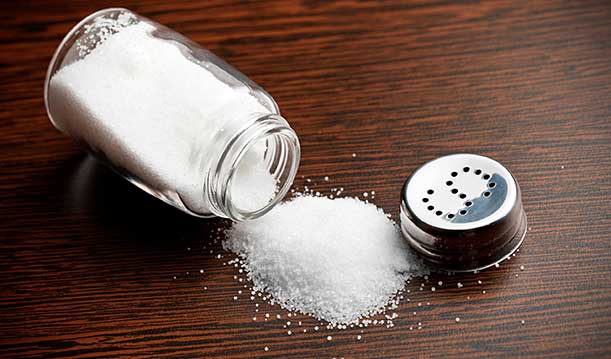Eating Right with Less Salt

Eating Right with Less Salt
The sodium in salt plays a role in high blood pressure. (Salt is the common name for sodium chloride.) The 2010 Dietary Guidelines for Americans recommends that everyone, even children, reduce their sodium intake to less than 2,300 milligrams a day. That’s about the same amount of sodium in one teaspoon of salt. Adults age 51 and older, African Americans of any age and individuals with high blood pressure, diabetes or chronic kidney disease should further reduce sodium intake to 1,500 milligrams a day.
Here are ways you can eat right with less salt:
1- Focus on fresh foods
Many foods in their original form, such as fruits, vegetables, fresh meats, poultry, fish, dry beans, eggs, milk, yogurt and grains like rice are naturally low in sodium. Include these foods more often in meals and snacks.
2- Eat processed and prepared foods less often
Highly processed and ready-to-eat foods tend to be higher in sodium. Eat these foods only occasionally or in smaller amounts – especially cheesy foods, such as pizza; cured meats such as bacon, sausage, hot dogs and deli or luncheon meats; and ready-to eat foods, like canned chili, ravioli and soups.
3- Cook more often at home
Enjoy home-prepared foods where you are in control of how much salt is added. Use little or no salt when cooking. Even if package instructions say to add salt to the water before boiling, it isn’t required and can be omitted. When using canned vegetables with salt added, be sure to drain and rinse the vegetables to reduce the amount of salt.
4- Try new flavors
Skip the salt and try salt-free seasonings such as herbs, spices, garlic, vinegar, black pepper or lemon juice. Make your own salt-free seasonings by combining herbs and spices.
5- Read food labels
Read the Nutrition Facts label and the ingredients list to find packaged and canned foods lower in sodium. Compare the amount of sodium listed and select the product with the lower amount. Look for foods labeled “low sodium,” “reduced sodium,” or “no salt added.”
6- Use caution with condiments
Foods like soy sauce, ketchup, pickles, olives, salad dressing and seasoning packets are high in sodium. Try low-sodium soy sauce and ketchup. Sprinkle only a small amount from a seasoning packet, not the entire amount.
7- Allow your taste buds to adjust
Like any change, it can take time for your taste buds to adapt to less salt. Foods lower in sodium may taste differently at first, but over time it’s possible to acquire a taste for foods with less salt.
Salt-free Seasoning Blends
Boost the flavor of foods with salt-free herb and spice blends. Combine ingredients and store in a tightly covered jar. Rub or sprinkle them on food for added flavor.
- Mixed herb blend: Mix together ¼ cup dried parsley flakes, 2 tablespoons dried tarragon and 1 tablespoon each of dried oregano, dill weed and celery flakes.
- Italian blend: Mix together 2 tablespoons each of dried basil and dried marjoram, 1 tablespoon each of garlic powder and dried oregano and 2 teaspoons each of thyme, crushed dried rosemary and crushed red pepper.
- Mexican blend: Mix together ¼ cup chili powder, 1 tablespoon each of ground cumin and onion powder, 1 teaspoon each of dried oregano, garlic powder and ground red pepper and ½ teaspoon cinnamon.



Previous comments
No Previous Comment
Add Comment